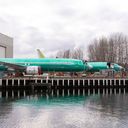Boeing timeline: Tracking the fallout of the door plug blowout

The mid-flight blowout of a Boeing 737 MAX 9 plane in January sent one of the world's top aerospace manufacturers into a tailspin.
The big picture: The Alaska Airlines door plug incident prompted a Federal Aviation Administration investigation, damaged Boeing's bottomline and reputation and put travelers on edge.
- While preliminary findings indicated missing bolts likely contributed to the blowout, the ongoing probe will determine the underlying cause and who is responsible.
Here's a timeline of how we got here.
Past problems with 737 MAXs
The January incident wasn't the first time Boeing's 737 MAX jets have been the subject of manufacturing and safety concerns.
Flashback: Two 737 MAX 8 crashes in Indonesia and Ethiopia in Oct. 2018 and March 2019 killed a combined 346 people, resulting in a temporary global grounding of the jets.
- Boeing announced in 2019 that it would give $100 million to the families and communities impacted by the fatal crashes.
- Eventually the FAA cleared Boeing's 737 MAX to fly again in the U.S. in November 2020.
Last December, Boeing urged airlines to conduct inspections of their 737 Max jets for potential loose hardware in the aircraft's rudder control systems.
- The company's warning came after an unnamed international airline discovered a "bolt with a missing nut" during a routine maintenance inspection.
January 2024: The door plug blowout
On Jan. 5, an Alaska Airlines Boeing 737 MAX 9 saw its a "plugged" emergency exit door fly off mid-flight, leaving a gaping hole in the plane's fuselage while it was at an altitude of nearly 16,000 feet.
- The next day, the FAA ordered all Boeing 737 MAX 9 planes in U.S. territory to be temporarily grounded.
Passengers from the Alaska Airlines flight filed a lawsuit against Boeing. In March, Boeing denied legal responsibility and argued that the suit should be dismissed, NBC News reported.
- Days after the January crash, a second group of passengers filed a separate lawsuit in Washington state court against Boeing and Alaska Airlines.
Subsequent inspections by Alaska and United Airlines of Boeing's MAX 9 jets revealed quality control issues, including loose bolts.
- The FAA announced that it would increase oversight of Boeing's production and manufacturing, including via an audit of the 737-9 MAX production line.
- The FAA cleared Boeing's 737 MAX 9 aircraft to resume flights at the end of January.
February 2024: Fallout continues
Boeing announced that some 50 undelivered 737 MAX jets would be reworked after misdrilled holes were identified on some fuselages.
- A federal watchdog said that preliminary findings indicated that missing bolts likely contributed to the Alaska Airlines door plug blowout.
- Boeing replaced the head of its 737 MAX program.
- Three passengers from Alaska Airlines Flight 1282 filed another lawsuit against the airline and Boeing, seeking $1 billion in damages.
An independent panel's review of Boeing's practices highlighted concerns about how the company manages safety.
- The FAA gave Boeing 90 days to create a plan to address its "systemic quality-control issues." The company said it was "totally committed to meeting this challenge" and would develop the plan.
March 2024: Investigative issues surface
A federal watchdog in March highlighted roadblocks in the investigation into the door plug incident while additional issues with Boeing aircraft surfaced.
- The National Transportation Safety Board (NTSB) launched an investigation into a February United Airlines Boeing 737-8 flight in which the aircraft experienced "stuck" rudder pedals after landing.
- Several other Boeing aircraft flown by United Airlines experience issues, including flames spewing from an engine and a lost tire after takeoff.
Friction point: The NTSB said it hasn't received documents from Boeing crucial to its investigation into the door plug blowout — despite the documents being "requested numerous times."
- Boeing said that it had supported the NTSB's investigation and provided names of employees who would have relevant information.
- The NTSB revealed that Boeing overwrote security camera footage of repair work done on the door plug of the Alaska Airlines plane that experienced the blowout.
Zoom in: The FAA's audit of Boeing's 737 Max production line unveiled numerous issues with the company's production process, including "manufacturing process control, parts handling and storage, and product control."
Go deeper: